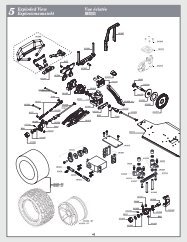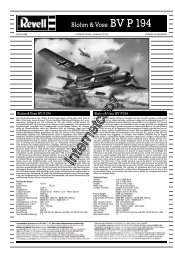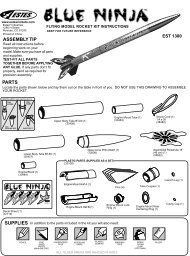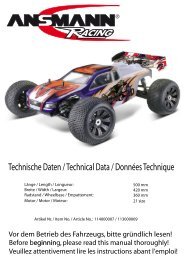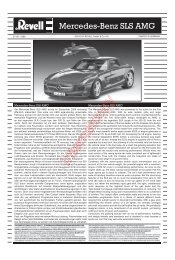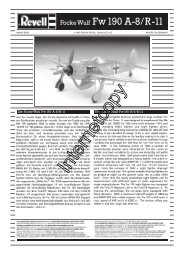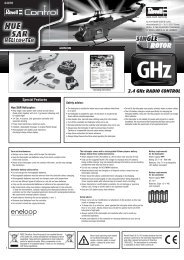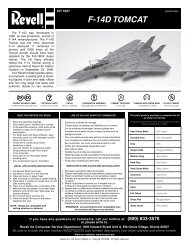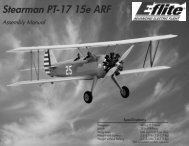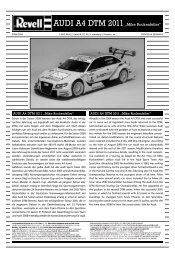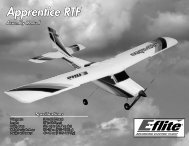P-40 Warhawk 300 ARF - Stanbridges Hobby Shop
P-40 Warhawk 300 ARF - Stanbridges Hobby Shop
P-40 Warhawk 300 ARF - Stanbridges Hobby Shop
You also want an ePaper? Increase the reach of your titles
YUMPU automatically turns print PDFs into web optimized ePapers that Google loves.
CE Compliance Information for the<br />
European Union<br />
Instructions for Disposal of WEEE by Users in<br />
the European Union<br />
This product must not be disposed of with other waste.<br />
Instead, it is the user’s responsibility to dispose of their<br />
waste equipment by handing it over to a designated<br />
collection point for the recycling of waste electrical<br />
and electronic equipment. The separate collection<br />
and recycling of your waste equipment at the time<br />
of disposal will help to conserve natural resources<br />
and ensure that it is recycled in a manner that<br />
protects human health and the environment. For more<br />
information about where you can drop off your waste<br />
equipment for recycling, please contact your local city<br />
office, your household waste disposal service or where<br />
you purchased the product.<br />
2009 Official Academy of Model<br />
Aeronautics Safety Code<br />
GENERAL<br />
1. A model aircraft shall be defined as a nonhuman-carrying<br />
device capable of sustained<br />
flight in the atmosphere. It shall not exceed<br />
limitations established in this code and is<br />
intended to be used exclusively for recreational<br />
or competition activity.<br />
2. The maximum takeoff weight of a model aircraft,<br />
including fuel, is 55 pounds, except for those<br />
flown under the AMA Experimental Aircraft<br />
Rules.<br />
3. I will abide by this Safety Code and all rules<br />
established for the flying site I use. I will not<br />
willfully fly my model aircraft in a reckless and/<br />
or dangerous manner.<br />
4. I will not fly my model aircraft in sanctioned<br />
events, air shows, or model demonstrations until<br />
it has been proven airworthy.<br />
5. I will not fly my model aircraft higher than<br />
approximately <strong>40</strong>0 feet above ground level,<br />
when within three (3) miles of an airport without<br />
notifying the airport operator. I will yield the<br />
right-of-way and avoid flying in the proximity<br />
of full-scale aircraft, utilizing a spotter when<br />
appropriate.<br />
6. I will not fly my model aircraft unless it is<br />
identified with my name and address, or AMA<br />
number, inside or affixed to the outside of the<br />
model aircraft. This does not apply to model<br />
aircraft flown indoors.<br />
7. I will not operate model aircraft with metal-blade<br />
propellers or with gaseous boosts (other than<br />
air), nor will I operate model aircraft with fuels<br />
containing tetranitromethane or hydrazine.<br />
8. I will not operate model aircraft carrying<br />
pyrotechnic devices which explode, burn, or<br />
propel a projectile of any kind. Exceptions<br />
include Free Flight fuses or devices that burn<br />
producing smoke and are securely attached to<br />
the model aircraft during flight. Rocket motors<br />
up to a G-series size may be used, provided<br />
they remain firmly attached to the model aircraft<br />
during flight. Model rockets may be flown in<br />
accordance with the National Model Rocketry<br />
Safety Code; however, they may not be launched<br />
from model aircraft. Officially designated AMA<br />
Air Show Teams (AST) are authorized to use<br />
devices and practices as defined within the Air<br />
Show Advisory Committee Document.<br />
9. I will not operate my model aircraft while under<br />
the influence of alcohol or within eight (8) hours<br />
of having consumed alcohol.<br />
10. I will not operate my model aircraft while using<br />
any drug which could adversely affect my ability<br />
to safely control my model aircraft.<br />
11. Children under six (6) years old are only allowed<br />
on a flightline or in a flight area as a pilot or<br />
while under flight instruction.<br />
12. When and where required by rule, helmets<br />
must be properly worn and fastened. They must<br />
be OSHA, DOT, ANSI, SNELL or NOCSAE<br />
approved or comply with comparable standards.<br />
RADIO CONTROL<br />
1. All model flying shall be conducted in a manner<br />
to avoid flying over unprotected people.<br />
2. I will have completed a successful radio<br />
equipment ground-range check before the first<br />
flight of a new or repaired model aircraft.<br />
3. I will not fly my model aircraft in the presence of<br />
spectators until I become a proficient flier, unless I<br />
am assisted by an experienced pilot.<br />
E-flite P-<strong>40</strong> <strong>Warhawk</strong> Assembly Manual<br />
17



